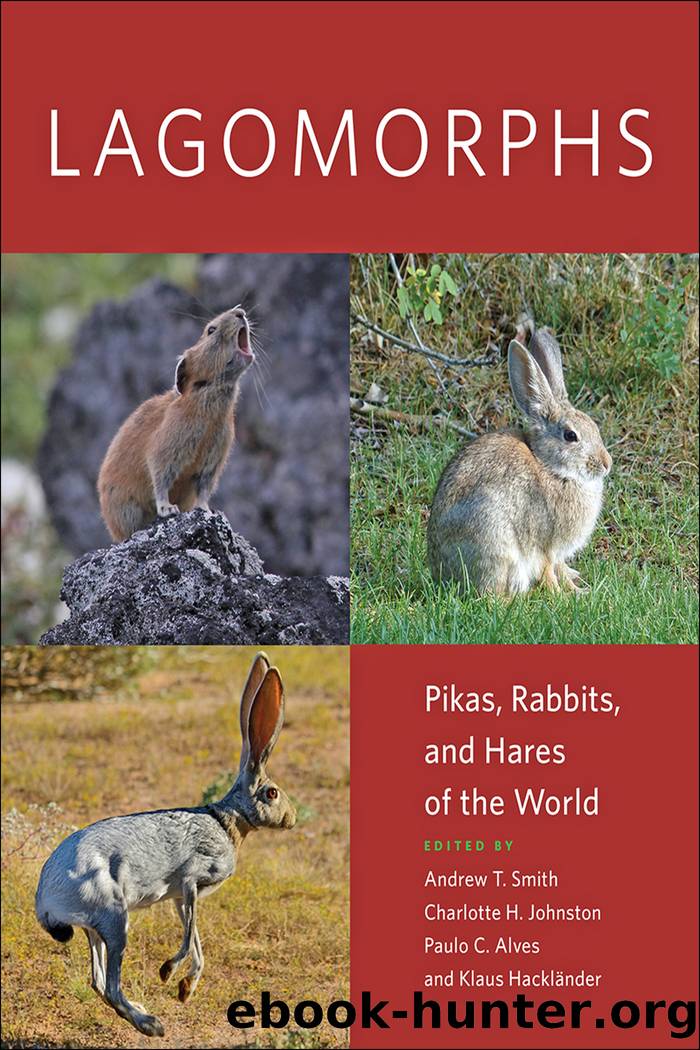Lagomorphs by Andrew T. Smith

Author:Andrew T. Smith
Language: eng
Format: epub
Publisher: Johns Hopkins University Press
Published: 2017-02-15T00:00:00+00:00
Omiltemi Rabbit
OTHER COMMON NAMES: Omiltemi cottontail; Conejo de Omiltemi, Conejo (Spanish)
DESCRIPTION: The Omiltemi rabbit is a medium-sized cottontail that has a short tail, medium-sized hind feet, and medium-sized ears. The dorsal and nape pelage is rufous black. The ears are black-brown, the sides are grayish black, and the tail is reddish black on the dorsal surface and dingy buffy on the ventral surface. The sides of the nose and the orbital area have dingy buffy grayish coloration. The ventral surface of the cottontail rabbit is buffy brown. There is a significant amount of white on the dorsal surface of the hind feet.
The skull is medium-sized with a long palate; it has a broad braincase, a narrow breadth across the nasals, large maxillary and mandibular tooth rows, short incisive foramina, a short diastema, a narrow basioccipital, and medium-sized auditory bullae, and is broad across the carotid foramina with a narrow breadth across the infraorbital canals. The shield-bulla depth is shallow as well as the skull depth. The supraoccipital shield is squared, and the posterior section of the supraorbital process is slender and flat.
SIZE: Head and body 398â440 mm; Tail 40â45 mm; Hind foot 89â104 mm; Ear 60â76 mm; Greatest length of skull 77â78 mm
CURRENT DISTRIBUTION: The Omiltemi rabbit has a very restricted distribution, less than 500 km² within the Sierra Madre del Sur, Guerrero, Mexico. This rabbit lives in a highly fragmented area within a natural reserve, the Omiltemi State Park (Parque Ecológico Estatal Omiltemi) in the Sierra Madre del Sur. It occurs at elevations between 2,133 and 3,505 m.
TAXONOMY AND GEOGRAPHIC VARIATION: No subspecies. The phylogenetic relationship of S. insonus with other species of Sylvilagus is unclear. Morphological comparisons between the tapetà (S. brasiliensis), Diceâs cottontail (S. dicei), and the Omiltemi rabbit indicate that the tapetà and Diceâs cottontail are more closely related to each other than either is to the Omiltemi rabbit. The Omiltemi rabbit is one of the most poorly known of all mammals; it is represented by only five museum specimens, four complete and one with only a skin.
ECOLOGY: Very little is known about the natural history of the Omiltemi rabbit. It is sympatric with the Mexican cottontail (S. cunicularius). It creates runways within the dense undergrowth, and occupies burrows under rocks or other similar shelters.
HABITAT AND DIET: The preferred habitat of the Omiltemi rabbit is dense cloud forest, where pines (Pinus), oaks (Quercus), and alders (Alnus) are abundant.
BEHAVIOR: The Omiltemi rabbit is mainly a nocturnal species.
PHYSIOLOGY AND GENETICS: Comparative phylogenetic analysis based on partial sequences (560 bp) of the gene 16S between eight species of Sylvilagus showed that the Omiltemi rabbit is most closely related to the desert cottontail (S. audubonii) and the Mexican cottontail instead of the tapetà as had been proposed previously. The sympatric distribution between the Omiltemi rabbit and the Mexican cottontail (in Guerrero, Mexico) seems to support the close relationship between these species. Genetic analysis using partial sequences of cytochrome b gene revealed an average genetic divergence of 15% between the Omiltemi rabbit and the Mexican cottontail.
Download
This site does not store any files on its server. We only index and link to content provided by other sites. Please contact the content providers to delete copyright contents if any and email us, we'll remove relevant links or contents immediately.
Machine Learning at Scale with H2O by Gregory Keys | David Whiting(4172)
Never by Ken Follett(3787)
Fairy Tale by Stephen King(3216)
Will by Will Smith(2790)
Hooked: A Dark, Contemporary Romance (Never After Series) by Emily McIntire(2496)
The Dawn of Everything: A New History of Humanity by David Graeber & David Wengrow(2122)
The Becoming by Nora Roberts(2085)
The Strength In Our Scars by Bianca Sparacino(1776)
HBR's 10 Must Reads 2022 by Harvard Business Review(1776)
A Short History of War by Jeremy Black(1758)
Go Tell the Bees That I Am Gone by Diana Gabaldon(1685)
515945210 by Unknown(1598)
A Game of Thrones (The Illustrated Edition) by George R. R. Martin(1587)
Bewilderment by Richard Powers(1535)
443319537 by Unknown(1466)
The 1619 Project by Unknown(1382)
The Real Anthony Fauci: Bill Gates, Big Pharma, and the Global War on Democracy and Public Health (Childrenâs Health Defense) by Robert F. Kennedy(1366)
How to Live by Derek Sivers(1319)
I Will Find You by Harlan Coben(1270)
